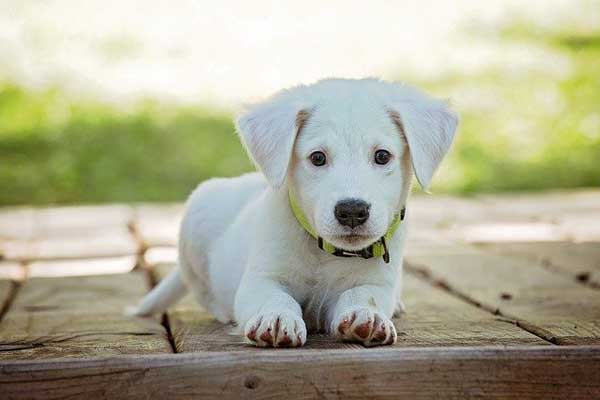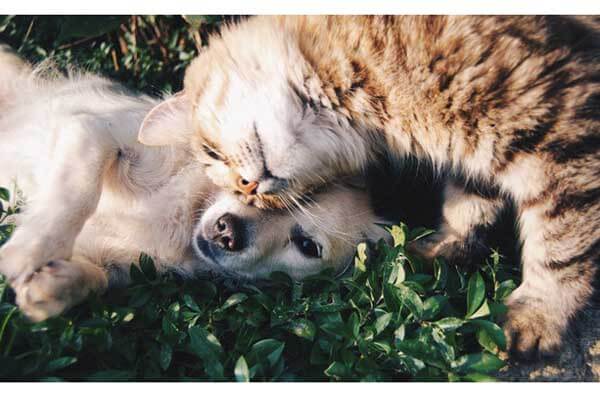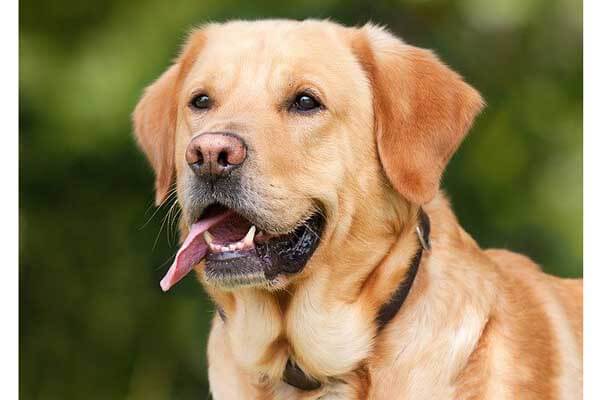Treat your dog to a relaxing massage that will improve her health, too.
Judson wasn’t sure about flying to New Orleans. “He just couldn’t settle down,” says Shelley Rhodes, surprised at her 6-year-old guide dog’s behavior on the plane that day. “He kept whining and panting and fidgeting.”
Massage techniques she’d learned while training with Judson at Guide Dogs for the Blind in San Rafael, Calif., helped calm the Golden Retriever. “I started to do ear touches,” says Rhodes, an assistive technology instructor from Corry, Pa. “It worked. After a few touches, he settled down and was able to lie in front of my seat.”
A guide dog’s work is based on the close bond he has with the person holding the harness. But flying on planes, judging traffic, and needling through construction areas can all stress that bond. Recognizing how human touch can help alleviate tension and reaffirm the bond, guide dog schools to offer their students classes in canine massage.
“Massage is really a lovely way to interact with the dogs, reinforce the bond,” says Lea Johnson, an instructor at Seeing Eye, which breeds and trains guide dogs in Morristown, N.J.
Why Massage?
The same techniques used with guide dogs can help any dog owner enjoy a closer relationship with his or her dog. Massage brings dogs and their owners’ other benefits as well, including:
- Increased circulation, which can improve a dog’s health.
- Earlier awareness of lumps and unusual growths.
- Deeper attachment between dog and owner, allowing them to bond further.
- Extended praise for the dog.
- Increased acceptance of handling by the dog.
- Stress and heart rate reduction for the owner.
- Reduced stress by lowering the dog’s heart rate and providing a quiet, relaxing experience.
Liz Hare, a canine geneticist in Garrison, N.Y., can vouch for that last one. “For me, it’s like meditation. It’s a way to be really calm and mindful,” she says, giving 12-year-old retired guide dog Ben a pat as he sleeps at her feet. “I do it in the evening when I want to relax and clear my mind.”
Getting Started
Consult your dog’s veterinarian before beginning a massage program.
If working with a fragile dog or one with limited mobility due to a joint problem, an injury, or surgery, knowledge of canine anatomy and biomechanics is essential, says Carla Campbell, a Seeing Eye graduate and canine masseuse in Menlo Park, Calif. In those situations, it really does pay to call in a pro, she advises.
Never massage your dog if he’s in shock or has a fever, or if you suspect he has a serious injury or illness not yet diagnosed. In addition, don’t massage an area with a skin infection, lump, or open or infected wound. And check with your veterinarian before massaging any dog who has cancer.
If your dog’s good health allows you to proceed, pick a word or phrase to let your dog know it’s time for a massage. Your dog will learn to recognize this and settle down happily for massages. Wait to start until after a potty break and at least 15 minutes after feeding, find a quiet spot, and put on some soothing music. Whether or not your dog responds to tunes, the music will help you stay relaxed and keep your strokes slow and even.
Relax and sit in a comfortable position that allows you to breathe deeply and steadily, or stand at a hip-high table. Approach your dog gently, speak softly, and start the massage routine.
Here’s How
The Seeing Eye takes its techniques for a massage from “The Healing Touch for Dogs: The Proven Massage Program for Dogs” (Newmarket, 2004) by Michael W. Fox, BVM, Ph.D. The book includes the following sequence for a calm and relaxing massage that will make your dog feel great!
- Stroke your dog’s back with both hands, from the back of the head to the base of the tail. Stroke in line with the lay of the fur.
- Using your fingertips, make small circular motions on each side of the spine, first clockwise, then counterclockwise. Start near the shoulders, and work your way to the tail’s base.
- Apply gentle pressure with your thumbs, on each side of the spine. Pressure should be vertical, through the dog, toward the paws.
- Still working on the back, lift excess skin up. Roll or knead between your thumbs and fingers, starting at the shoulders and working your way to the tail’s base.
- Massage the rump area, using circular finger movements.
- Feel for the base of the skull, where the head joins the back of the neck. Place your fingers on one side, thumb on the other, to massage.
- Slide your hands forward to massage your dog’s cheek muscles.
- Flatten your hand, and stroke your dog from nose to top of the head, following the lay of the fur.
- Take hold of the ears at their base. Gently pull from base to tip, rubbing earflaps between your fingers as you go.
- With your dog lying on his side, use your fingers and hands to massage his shoulder muscles with deep, slow, circular movements.
- Gently massage the forelegs between fingers and thumb, working your way toward the paws.
- Squeeze the muscles along and between the toes.
- Move each toe up and down with a gentle, vibrating movement.
- Gently flex the paw, extending it inward and rotating, to relax tendons.
- Use both hands to give the thigh a deep massage.
- Use your fingers to massage the hip joint in a circular pattern.
- Massage down the back leg toward the foot. Massage paw and toes.
- Help your dog turn over, then massage his legs on the other side.
- To finish, talk calmly to your dog while using slow palm and finger strokes from the head down the back to the tip of the tail. Do the same from the hip to the hindfoot and shoulders to forepaw.
The Tellington TTouch massage program taught at Guide Dogs for the Blind is more specific, using a combination of different lifts, movement exercises, and touches — like the ear touch Rhodes used on Judson’s plane ride — to activate the nervous system. “It’s done on the skin,” Rhodes explains, “but the dog feels effects through his whole body.”
Guided to work by 4-year-old Golden Retriever Justin, Campbell does massage in coordination with veterinarians. “I work on dogs of all ages and sizes: companion dogs, working dogs, and show dogs. From Cavalier King Charles Spaniels to Mastiffs and everything in between,” she says. “I love my job!”
By Beth Finke
How to Give Your Dog a Doggie Relaxing Massage
A Doggie Relaxing Massage is a great way to bond with your dog and relax him. Apart from reducing your own stress, canine massage is also beneficial to your dog’s health. This can relieve pain, arthritis, and injury recovery. Best of all, canine massage is a non-invasive procedure, which is a great way to give your dog a well-deserved rest. Moreover, it will make your dog feel better, which will ultimately lead to quality time together.
First, start your massage session by giving your dog a gentle stroking motion on his back. Gently massage the muscles on his back, legs, and tail. Be sure to squeeze his tail from its base to its tip. If you find that his tail has a knot, you can use a small compression. Repeat this process as many times as necessary until your dog is relaxed. Afterward, try to apply a light massage pressure on other parts of his body.
While massaging your dog, remember to use light to medium pressure. Always use your entire hand to massage your dog. You should use light to medium pressure. Do not press too hard or too softly. Lastly, remember to breathe deeply as you stroke your dog. The rhythm of your breathing will help your dog relax and get a good night’s sleep. This massage will make your dog feel relaxed and rejuvenated. It will also be easier to notice any changes in your dog’s behavior.
Using your hands to rub your dog’s body is an excellent way to soothe the nervous system. While massaging, you should start by holding one hand at the base of his neck, and then move up to his back legs and tail. If your dog does not respond to your massage, you should stop the massage immediately. You should also avoid over-pressuring your dog as this could lead to injuries. If your dog is uncomfortable during a massage, make sure to take a break from the massage for a while.
To give your dog a Doggie Relaxing Massage, start with the back of your dog. The back of a dog is prone to injury, so you should gently massage it. After this, move up your hand to the front of its head and squeeze it. If you want to give your pet a deep-tissue massage, you should start by rubbing the back of his tail. This will relax your dog’s tail.
A Doggie Relaxing Massage is an excellent way to reduce stress and increase circulation. Moreover, it can strengthen the bond between you and your dog. As a bonus, a Doggie Relaxing Massage can be performed anywhere on your dog’s body, whether it is the head, butt, or neck. During the massage, you should use both hands to gently touch your dog’s head and butt. The hands should be placed in a similar way.
Begin your Doggie Relaxing Massage by massaging its back. The muscles of the back can be massaged using a variety of hand movements. It is not necessary to use heavy pressure or rub it vigorously. Instead, it should be light and gentle. A few minutes of this massage will be enough. It will help you and your dog relax and learn the different characteristics of your pet’s body. The sessions should not be long, and the duration should be adjusted according to the length of the massage.
The massage should be gentle and relaxing for both you and your dog. The dog’s head and butt will usually present themselves for petting, so start massaging from these areas. While it may not be the best method to soothe your dog, it will help him relax and help you relax. If you do it regularly, your dog will soon become accustomed to the routine and will look forward to it. Once your dog becomes comfortable with it, you should continue the massage.
While massaging, keep your dog in mind that your dog may not respond to the massage. Watch his body language and monitor his movements. If he moves away from you during the massage, it might not be a pleasant experience for him. When massaging, do not overdo it. Don’t force him to relax. Involve your dog as much as possible. Only then will your dog become comfortable with the massage.








